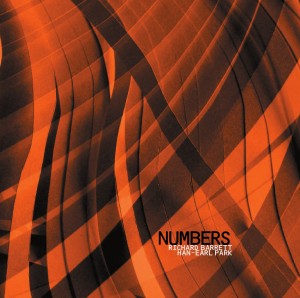
To be released by Creative Sources Recordings in November 2011 2011/2012: ‘Numbers’ (CS 201 cd) with Richard Barrett and Han-earl Park [about this duo…]. More info to follow…
updates
11–15–11: update release schedule [details…].

To be released by Creative Sources Recordings in November 2011 2011/2012: ‘Numbers’ (CS 201 cd) with Richard Barrett and Han-earl Park [about this duo…]. More info to follow…
11–15–11: update release schedule [details…].
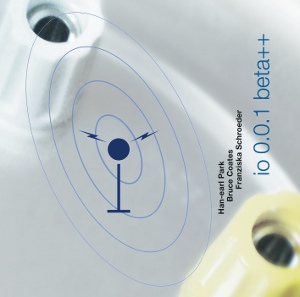
SLAM Productions releases ‘io 0.0.1 beta++’ (SLAMCD 531), an audio CD documenting the real-time interactions between human and machine musicians, featuring the musical automaton io 0.0.1 beta++ with the human performers Han-earl Park, Bruce Coates and Franziska Schroeder. [Details of the recording…]
[Get it from Slam Productions…]
[Get it from distributors/shops…] [Downtown Music Gallery…] [Jazzcds…] [Souffle Continu…] [Squidco…] [Wayside Music…]
In addition to the physical CD, if you prefer your music compressed…
Note: I still recommend the physical CD, however, as it comes with Sara Roberts’ smart, witty and illuminating liner notes.
io 0.0.1 beta++ (itself), Han-earl Park (guitar), Bruce Coates (alto and sopranino saxophones) and Franziska Schroeder (soprano saxophone).
Pioneer: Variance (11:52); Pioneer: Dance (13:13); Ground-Based Telemetry (1:42); Discovery: Intermodulation (9:08); Discovery: Decay (5:08); 4G (0:59); Laplace: Perturbation (10:21); Laplace: Instability (3:08); Return Trajectory (8:24). Total duration: 63:57.

The construction of io 0.0.1 beta++ has been made possible by the generous support of the Arts Council of Ireland.
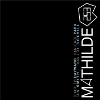
Also available from SLAM Productions: Mathilde 253 (SLAMCD 528) [details…]
Performers: Charles Hayward (drums, percussion and melodica), Han-earl Park (guitar) and Ian Smith (trumpet and flugelhorn) plus Lol Coxhill (saxophone).
© 2010 Han-earl Park.
℗ 2010 SLAM Productions.
08–18–11: add Jazzcds to list of shops.
02–15–12: add Souffle Continu to list of shops.
03–28–12: add Squidco to list of shops.
Press/publicity photos and images of Mathilde 253 (Charles Hayward, Han-earl Park and Ian Smith) are now collated at:
https://goo.gl/photos/E8XrSrUML3Xee7MU7
Photographs copyright the photographers. If you use any of the images, please credit the corresponding photographer. [Additional images…].
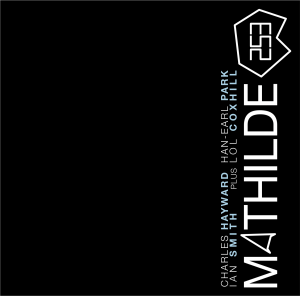
Charles Hayward defies the laws of physics, Ian Smith blows particles into space, Lol Coxhill contributes to the celestial harmony, and my playing is like a pulsar! Vincenzo Roggero gives Mathilde 253 (SLAMCD 528) an astro-poetic spin at All About Jazz Italia:
Le percussioni di Charles Hayward sono impulsi, fremiti di pelli, vibrazioni di metalli che interagiscono con lo spazio, oggetti che sfuggono alle leggi della fisica e della forza di gravità. Le corde della chitarra di Han-Earl Park sono pulsar che lanciano segnali dallo spazio, onde elettromagnetiche che contaminano la scena e ne modificano continuamente le sembianze. La tromba… di Ian Smith vaga errabonda in questo vuoto pneumatico deformando suoni, riflettendo immagini che si disintegrano come pulviscolo spaziale.
Nella sua orbita l’asteroide Mathilde 253 intercetta il pianeta Lol Coxhill, ma il rischio collisione è scongiurato. Anzi. L’armonia celeste è assicurata dall’uso del medesimo linguaggio di ricerca e di libertà. [Read the rest…]
Mathilde 253’s eponymous debut CD (SLAMCD 528) available on SLAM Productions. [More info…] [All reviews…] [Get the CD…]

Released as part of SLAM Productions’s August 2011 CD catalog: ‘io 0.0.1 beta++’ (SLAMCD 531) with Han-earl Park, Bruce Coates and Franziska Schroeder.
[Slam Productions catalog page…]
[www.io001b.com page…]
[Discography entry…]
We watch and listen carefully because we know we’re seeing a kind of manifesto in action. What is an automaton? A sketch, a material characterization of the ideas the inventor and the inventor’s culture have about some aspect of life, and how it could be. io and its kind are alternate beings born of ideas, decisions and choices. It is because io stands alone, an automaton, that the performance recorded on this CD not only is music, but is about music.
Sara Roberts (from the liner notes)
An extraordinary meeting between human and machine improvisers. Featuring the machine musician io 0.0.1 beta++ with guitarist Han-earl Park (Mathilde 253, Wadada Leo Smith) and saxophonists Bruce Coates (Birmingham Improvisers’ Orchestra, Paul Dunmall) and Franziska Schroeder (FAINT, Evan Parker), the recording is part critique and part playful exploration, both a boundary-breaking demonstration of socio-musical technologies and an ironic sci-fi parody.
Constructed by Han-earl Park, io 0.0.1 beta++ is a modern-day musical automaton. It is not an instrument to be played but a non-human artificial musician that performs alongside its human counterparts. io 0.0.1 beta++ represents a personal-political investigation of technology, interaction, improvisation and musicality. It whimsically evokes a 1950s B-movie robot—seemingly jerry-rigged, constructed from ad-hoc components including plumbing, kitchenware, speakers and missile switches—celebrating the material and corporeal.
The performances with this artificial musician highlight society’s entanglement with technology, demonstrate alternative modes of interfacing the musical and the technological, and illuminate the creative and improvisative processes in music. The performance is a radical and playful engagement with powerful and problematic dreams (and nightmares) of the artificial; a dream as old as the anthropology of robots.
With liner notes by the California-based interactive media artist Sara Roberts.
io 0.0.1 beta++ was constructed by Han-earl Park with funding from the Arts Council of Ireland, and with significant input and feedback from Bruce Coates, Franziska Schroeder, Murray Campbell, Sara Roberts and Phil Burk.
We would like to thank John Hough, Melanie L Marshall, Alex Fiennes, Kato Hideki, John Godfrey, Clair McSweeney, Riccardo Vallebella, Paul Everett, Mel Mercier, Kevin Terry and Stephanie Hough.
The recording preceded the performance at Blackrock Castle Observatory which was presented with funding from the Music Network Performance and Touring Award, and support from Blackrock Castle Observatory, the Castle Bar and Trattoria and the UCC Department of Music.
io 0.0.1 beta++ (itself), Han-earl Park (guitar), Bruce Coates (alto and sopranino saxophones) and Franziska Schroeder (soprano saxophone).
Pioneer: Variance (11:52); Pioneer: Dance (13:13); Ground-Based Telemetry (1:42); Discovery: Intermodulation (9:08); Discovery: Decay (5:08); 4G (0:59); Laplace: Perturbation (10:21); Laplace: Instability (3:08); Return Trajectory (8:24). Total duration: 63:57.
All music by Han-earl Park, Bruce Coates and Franziska Schroeder.
Tracks 1–5, 7 and 8 recorded May 25, and track 9 recorded May 26, 2010 at the Ó Riada Hall, UCC Department of Music, Cork. Track 6 recorded August 19 2010 at C-ALTO Labs, Cork.
Recorded and mixed by Han-earl Park.
Design and artwork by Han-earl Park.
© 2011 Han-earl Park. ℗ 2011 SLAM Productions.
io 0.0.1 beta++ whimsically evokes a 1950s B-movie robot, constructed from ad-hoc components including plumbing, kitchenware and missile switches. Its celebrates the material and corporeal; embracing the localized and embodied aspects of sociality, performance and improvisation.
io 0.0.1 beta++ is an interactive, semiautonomous technological artifact that, in partnership with its human associates, performs a deliberately amplified staging of a socio-technical network—a network in which the primary protocol is improvisation. Together the cyborg ensemble explores the performance of identities, hybrids and relationships, and highlights the social agency of artifacts, and the social dimension of improvisation. Engineered by Han-earl Park, io 0.0.1 beta++ is a descendant, and significant re-construction, of his previous machine musicians, and it builds upon the work done with, and address some of the musical and practical problems of, these previous artifacts.
The construction of io 0.0.1 beta++ has been made possible by the generous support of the Arts Council of Ireland.
Improviser, guitarist and constructor Han-earl Park (박한얼) has been working within/from/around traditions of fuzzily idiomatic, on occasion experimental, mostly open improvised musics for over fifteen years, sometimes engineering theater, sometimes inventing ritual. He feels the gravitational pull of collaborative, multi-authored contexts, and has performed in clubs, theaters, art galleries, concert halls, and (ad-hoc) alternative spaces in Austria, Denmark, Germany, England, Ireland, The Netherlands, Scotland and the USA.
A constructor of low- and mid-tech electronic and software devices, and an occasional score-maker, he is interested in partial, and partially frustrating, context-specific artifacts; artifacts that amplify social relations and corporeal identities and agencies, and, in some instances, objects that obscure the location of the author.
He is part of Mathilde 253 with Charles Hayward and Ian Smith, is involved in collaborations with Bruce Coates, Franziska Schroeder, Alex Fiennes and Murray Campbell. Recent performances include Mathilde 253 with Ishmael Wadada Leo Smith; duo concerts with Paul Dunmall, and with Richard Barrett; trios with Matana Roberts and Mark Sanders, with Catherine Sikora and Ian Smith, and with Jin Sangtae and Jeffrey Weeter; as part of the Evan Parker-led 20-piece improvising ensemble; and the performance of Pauline Oliveros’ ‘Droniphonia’ alongside the composer. Park has also recently performed with Lol Coxhill, Pat Thomas, Corey Mwamba, Mark Trayle, Pedro Rebelo, Alexander Hawkins, Mike Hurley, Chick Lyall, Thomas Buckner and Kato Hideki. Festival appearances include Sonorities (Belfast), Sonic Acts (Amsterdam), dialogues festival (Edinburgh), VAIN Live Art (Oxford), and the Center for Experiments in Art, Information and Technology Festival (California). His recordings have been released by labels including SLAM Productions and DUNS Limited Edition.
Park founded Stet Lab, a monthly improvised music space in Cork, Ireland, and taught improvisation at the UCC Department of Music.
Bruce Coates has been heavily involved with free jazz, free improvisation and experimental music for more than 15 years. He has collaborated and performed with a long list of some of the best-known names in these areas. He is cofounder of the Birmingham Improvisers’ Orchestra, has a long standing working relationship in many different guises with guitarist Jamie Smith, a regular trio with David Ryan and bassist John Edwards and runs the monthly Birmingham FrImp night.
Recent collaborations have included regular performances with the saxophonist Paul Dunmall, appearing alongside Dunmall on his DUNS label (the only saxophonist to do so); the Paris-based Blackberry Orchestra led by Peter Corser and involving some of France’s best known improvisers including Denis Charolles and Guillaume Roy; and a CD with the Amsterdam based Mount Fuji Doom Jazz Corporation released on the Ad Noiseam label in 2007. Current ensembles include SCHH with Chris Hobbs, Mike Hurley and Walt Shaw; Magtal with Mark Sanders and Jonny Marks; and the performance art oriented Mutt with Marks and Shaw. His ever-growing eclectic list of collaborators also includes Tony Oxley, Lol Coxhill, Christian Wolff (performing alongside the composer at the Institute of Contemporary Arts, London), Hilary Jeffrey, Phil Gibbs, Paul Rogers, Trevor Lines, John Coxon, Misterlee, Bong Ra, Simon Picard, Tony Bianco, Han-earl Park, Tony and Miles Levin and Tony Marsh.
Franziska Schroeder is a saxophonist and theorist. She received her saxophone training in Berlin and Australia and later from Marie-Bernadette Charrier / Conservatoire Supérieure in Bordeaux.
With her trio FAINT Schroeder released a CD of improvised and electroacoustic music in 2007 with Pedro Rebelo (piano and instrumental parasites) and Steven Davis (drums), and a second CD, both on the creative source label. Schroeder has performed with many international musicians including Pauline Oliveros, Stelarc, the Avatar Orchestra, Chris Brown, John Kenny, Tom Arthurs, Nuno Rebelo and Evan Parker.
She holds a PhD from the University of Edinburgh and has written for many international journals, including Leonardo, Organised Sound, Performance Research, Cambridge Publishing and Routledge. Her book “Re-situating Performance Within The Threshold: Performance practice understood through theories of embodiment” appeared in 2009. Schroeder also published a book on user-generated content for Cambridge Publishing Scholars in 2009.
Schroeder is on the development committee of NMSAT (Networked Music & SoundArt Timeline), and has been on the programming committee for the DRHA (Digital Resources in the Humanities and Arts) conference since 2009. She was the Program Chair for the DRHA 2010. Schroeder has been an AHRC Research Fellow and is now a Lecturer/RCUK Fellow at the School of Music and Sonic Arts in Belfast, where she coaches 3rd year recitalists and MA performance students.

The construction of io 0.0.1 beta++ has been made possible by the generous support of the Arts Council of Ireland.

Also available from SLAM Productions: Mathilde 253 (SLAMCD 528) [details…]
Performers: Charles Hayward (drums, percussion and melodica), Han-earl Park (guitar) and Ian Smith (trumpet and flugelhorn) plus Lol Coxhill (saxophone).
© 2010 Han-earl Park.
℗ 2010 SLAM Productions.

Jeph Jerman’s take of Mathilde 253 (SLAMCD 528) at The Squid’s Ear:
…The trio interplay starts back up into territory that’s not quite free-jazz, not quite stereotypical British free improv, but somewhere in-between, with a slight rock-ist tinge. The stop/start modus continues, little cells erupting, sprawling and then halting, leaving guitar exposed again. [Han-earl] Park is the one to pay close attention to here, the development of his ideas is fascinating and very logical, and the other two players are embellishing and commenting on his story….
A section in which [Ian] Smith engages in high frequency squeaks makes my ears prick up, and what follows; ratcheting metallics, ringing scraped cymbals and odd muttering, is quite arresting…. On the last two pieces Lol Coxhill’s familiar sweet and sour tone joins in, initially in a duet with Park’s note-salad, as a carefully considered dialogue begins…. Coxhill seems to be having a lot of fun here, rubbing against the other’s ideas, or at times suggesting completely different areas for exploration. [Read the rest…]
Mathilde 253’s eponymous debut CD (SLAMCD 528) available on SLAM Productions …and from Squidco 😉 [More info…] [All reviews…] [Get the CD…]
First audio preview of the upcoming CD ‘io 0.0.1 beta++’! Hear the track ‘Discovery: Intermodulation’ on the latest edition of Taran’s Free Jazz Hour. [More…]
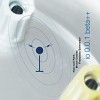
‘io 0.0.1 beta++’ (SLAMCD 531) will be released by SLAM Productions in August 2011.
Performers: io 0.0.1 beta++ (itself), Han-earl Park (guitar), Bruce Coates (alto and sopranino saxophones) and Franziska Schroeder (soprano saxophone).
© 2011 Han-earl Park.
℗ 2011 SLAM Productions.
I’m happy and honored to again have a recording selected as Download of the Day at All About Jazz. ‘Carrier’ by myself and Richard Scott is AAJ’s featured download for today! Thanks to Dave Sumner who runs the series for selecting the recording, and for the heads up. [Download the complete session…]
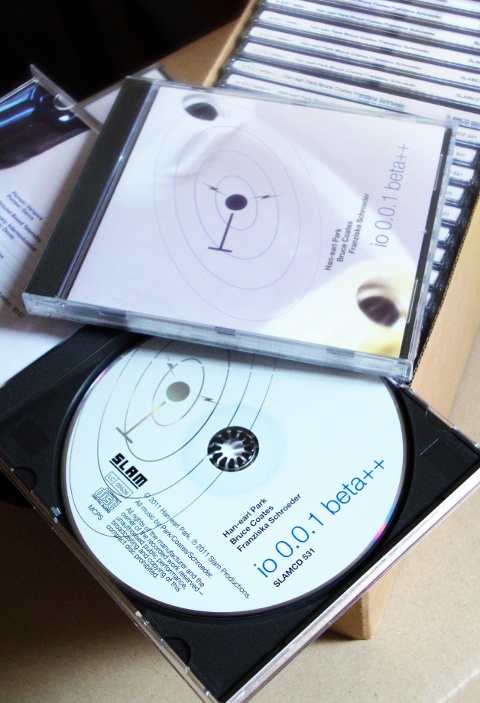
Available fall August 2011: ‘io 0.0.1 beta++’ (SLAMCD 531) with io 0.0.1 beta++ (itself), Han-earl Park (guitar), Bruce Coates (alto and sopranino saxophones) and Franziska Schroeder (soprano saxophone). © 2011 Han-earl Park. ℗ 2011 SLAM Productions. [More info…]
06–11–11: change release date to August 2011.
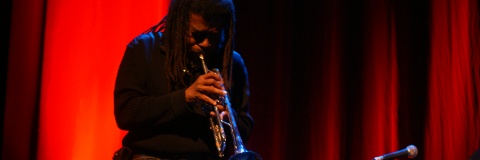
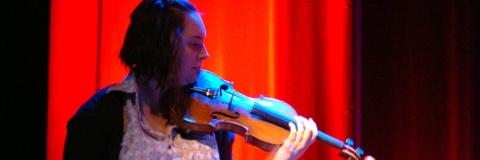

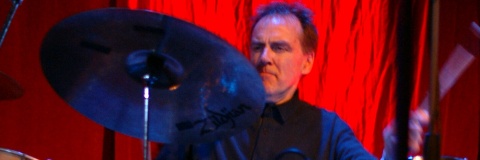

Photographs of (top to bottom) Ishmael Wadada Leo Smith, Marian Murray, and Mathilde 253 (Han-earl Park, Charles Hayward and Ian Smith) taken at the Half Moon Theatre (Cork Opera House, Emmet Place, Cork, Ireland), March 30, 2011 [Details…]. All photographs by, and copyright 2011, Julia Healy.
The performance was presented with funding from the Music Network Performance and Touring Award, and support from UCC School of Music and the Cork Opera House.
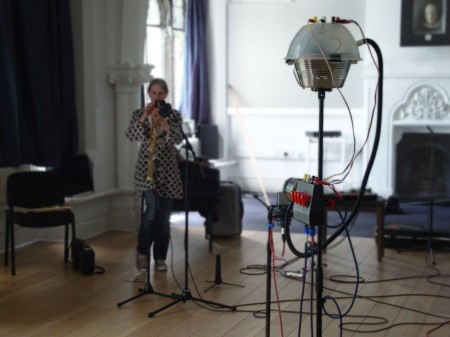
At the io 0.0.1 beta++ ’site, I’m posting short excerpts from the liner notes to ‘io 0.0.1 beta++’ (SLAMCD 531). Written by the California-based interactive media artist Sara Roberts, here’s the second excerpt:
io 0.0.1 beta++ is rather special in being both an instrument and a player. And given the two attributes it has a very particular sound, ‘sound’ here referring to both timbral quality and the broader sense of having an indelible identity, a style, having its own sound. [2]
io has an extravagant range of sounds made with superhuman amounts of air, and superhuman articulations of air resistance: a hummingbird trill that can go on without the limit of breath, bleats, blats, a grainy slur, shifts between piping and sandy sounds, elephant-like trumpeting, a faint spitty-sounding purr, slushy trills, a hoarse blast of full-spectrum noise, scumbling, whispery hisses ramping up to loud razzing. It can make delicate birdlike chirpings then abruptly sound like a power tool under duress, or render sounds reminiscent of emergency vehicles. [Original post at io 0.0.1 beta++…]
[2] George E. Lewis, ‘Interacting with Latter-Day Musical Automata’, Contemporary Music Review, Vol.18, No.3, 99–112 (1999).
© 2011 Sara Roberts.
Read the first excerpt: ‘a curious situation (liner notes: io 0.0.1 beta++)’. [All excerpts…]

‘io 0.0.1 beta++’ (SLAMCD 531) will be released by SLAM Productions in fall August 2011.
Performers: io 0.0.1 beta++ (itself), Han-earl Park (guitar), Bruce Coates (alto and sopranino saxophones) and Franziska Schroeder (soprano saxophone).
© 2011 Han-earl Park.
℗ 2011 SLAM Productions.
06–11–11: change release date to August 2011.
I’ve shut the CD store because of the move back to the United States. I plan to reinstate the purchase option, but I can’t say when at the moment. Some of these CDs are available from other sources, and these are indicated below.
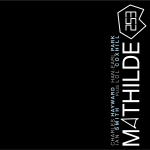
Mathilde 253 [details…]
Performers: Charles Hayward (drums, percussion and melodica), Han-earl Park (guitar) and Ian Smith (trumpet and flugelhorn) plus Lol Coxhill (saxophone).
[Get it from Slam Productions…]
[Get it from distributors/shops…] [Downtown Music Gallery…] [Jazzcds…] [Squidco…] [Wayside Music…]
[iTunes…] [eMusic…]
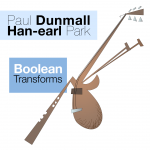
Boolean Transforms [details…]
Performers: Paul Dunmall (saxophone and bagpipes) and Han-earl Park (guitar).
[Get it from Mind Your Own Music…]
[Get it from Downtown Music Gallery…]
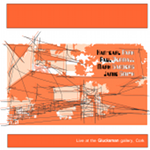
Live at the Glucksman gallery, Cork [details…]
Performers: Han-earl Park (guitar), Paul Dunmall (saxophone), Mark Sanders (drums) and Jamie Smith (guitar).